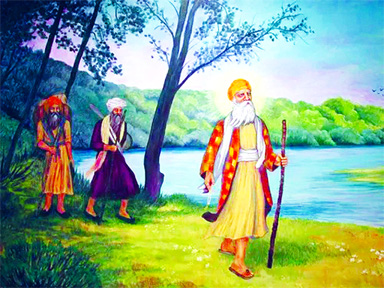
By Navtej Sarna
In a unique example of spiritual wanderlust, Guru Nanak spent more than 20 years on the road, spreading his message of love, compassion and equality of man. At a time when there were no quick or sophisticated means of travel, he undertook four long journeys, called udasis, signifying detachment. Though scholars have laid out detailed routes that he may have used, concrete evidence of the exact order of his travels is difficult to find. Indications of the places he visited as well as his experiences are contained in the janam-sakhis, written some decades after his passing. Some details can also be discerned from Guru Nanak’s own hymns as well as in the writings of Bhai Gurdas, the scholar and amanuensis who first inscribed the Adi Granth in Guru Arjan’s presence. Bhai Gurdas’s poetic vision describes Nanak’s immense travels thus: Babe tare char chak/ nau khand prithvi sacha dhoa (The Baba traversed the nine regions of the earth, as far as the land stretched).
It is believed that Guru Nanak certainly travelled as far as Assam in the east, present-day Sri Lanka in the south, Mount Kailash in the north and Mecca-Medina in the west. Some speculative accounts take Nanak even further afield. His mission took him to snowy heights and across burning deserts, through little villages and mighty capitals, among the ordinary as well as learned, to fairs, festivals, to temples, mosques, khanaqahs. These travels gave him an opportunity to observe the workings of the religions of the day in actual practice and to debate and discuss these matters of the spirit with sages and seers and also to dispel ignorance and blind ritualism, of which there was no dearth. Bhai Gurdas puts it thus: Dithe Hindu Turaki sabhi pir paikambari kaumi katele/ Andhi andhe khuhe thele (I saw Hindus and Muslims, holy men of all kinds/ The blind pushing the blind into a well).
Today, gurudwaras and shrines mark Nanak’s travels to these far-flung places; local legends further establish the fact that the Guru indeed travelled extensively. Nanak was accompanied by Mardana on his travels, who carried and played the rabab, and also became an interesting protagonist of the many sakhis that are attached to these travels. One cycle of janam-sakhis and several illustrations show another companion, Bhai Bala.
According to some sources, Guru Nanak dressed in strange clothes that could not be identified with any sect and symbolised the universality of his message. He wore a loose long shirt of a Muslim dervish but of brownish-red colour of the Hindu sanyasi. Around his waist he wore a white cloth belt like a fakir. A short turban Babe bhek banaia udasi ki riti chalai/ Charhia sodhan dharth lukai (The Baba donned robes, and in the tradition of detachment/ Went to put humanity on the right path) partly covered a qalandar’s conical cap in the manner of Sufi wanderers. His slippers were often of two different colours and designs. Sometimes it is said he wore a garland of human bones around his neck. As Bhai Gurdas wrote: Guru Nanak’s first journey took him to the east, as far as Assam and Dhaka. On the way, he visited places of pilgrimage, including Haridwar, Ayodhya, Varanasi, Kedarnath, Badrinath and Gaya. The janam-sakhis tell several tales of his discourses with learned yogis.
He also visited the Jagannath temple in Puri in Orissa. This temple is known for its annual procession when the idol is mounted on a huge chariot and the multitudes that gather vie with each other for the privilege of pulling the chariot. Here is one version of what happened there: when Guru Nanak and Mardana camped near the temple, their hymns and music attracted several devotees on their way to the temple, annoying the priests. One day, the chief priest came to Nanak and invited him to join the aarti (evening prayer) in the temple and Guru Nanak readily accompanied him. It was a beautiful ceremony, conducted at dusk. The priest placed earthen lamps filled with ghee on a bejeweled salver decorated with flower petals and sweet incense. They lit the wicks and swung the salver pendulum-like in front of the image while the congregation sang hymns, blew conches and tolled the bells. Nanak sat unmoved through the ceremony, and when the priests expressed their anger and surprise, he responded with a song now part of the Granth Sahib.
The song describes the celestial aarti in which the sky, the sun, the moon, the stars, the wind, the forests and the unstruck music pay obeisance to the great Creator. This, according to Nanak, was the true aarti that could be offered to God:
The sky the salver, the sun and moon the lamps, The stars studding the heavens are the pearls
The fragrance of sandal is the incense Fanned by the winds, all for thee The great forests are the flowers
What a beautiful aarti is being performed For you, O destroyer of fear.
The second journey took Guru Nanak south, to present-day Sri Lanka. He was accompanied by two Jat followers: Saido and Gheho.
The third udasi of Guru Nanak was to the north. He travelled widely in the Himalayas—several scholars have traced his steps to Himachal Pradesh, J&K, Uttar Pradesh, Sikkim, Ladakh and even Nepal and Tibet. The central event of this northern udasi is the visit to Mt Sumer, recorded in all the janam-sakhis and also by Bhai Gurdas—Mt Sumer is said to be none other than Mt Kailash, the abode of Shiv and Parvati. There took place his meeting with 84 siddhas, among them the ancient souls Goraknath, Machendranath and Charpat Nath, or perhaps their spiritual successors, who had meditated long and deep and possessed great power and wisdom.
In Bhai Gurdas’s version of the meeting, the siddhas express amazement at seeing Nanak: O youthful one! What power brings you to these heights? Who is that you worship? And Guru Nanak replied: the eternal Lord alone.
The siddhas ask him how the world below fared. Guru Nanak made no secret of what he felt. He said darkness, sin and injustice had taken over the world. Corruption was rampant; the fence itself had begun to eat the crop.
Sidh chhapi baithe parabati kaunu jagat kau par utara (The wise siddhas have escaped into the remote caves and mountains—who will then redeem the world?)
Guru Nanak had several meetings with siddhas and yogis, in particular with those of the kanphata (split-eared) sect. His discourse with these holy men, in question-and-answer form, is contained in his Siddha
Gosht, comprised of 73 verses in the Granth Sahib. The entire discourse is conducted in a spirit of humility, intellectual inquiry and tolerance. In this discourse, the siddhas argue that it was not possible to be part of the world and follow the path of meditation and spirituality. Nanak replied that one had to be as a lotus or a duck—to stay in the water but still remain dry. One had to be part of the world and yet be unaffected by it through meditation on His name. The fourth udasi took Guru Nanak to the west and to Islamic countries and important centres such as Mecca and Baghdad. It is said that he dressed in a blue robe in the manner of a Haji and carried a book, a staff and a small carpet for saying his prayers.
Phir Baba gaia Baghdad no bahari kia asthana/ Ik baba akal rupu duja rababi Mardana (Then Baba went to Baghdad and camped outside the city/ He himself one with the Timeless, and his rabab player Mardana).
Baghdad was then a great centre of Islamic learning, art and culture. On the outskirts of the city, in a graveyard, Mardana strummed the strings of his rabab in holy melody and Nanak sang hymns. When this was reported to the Pir-e-dastgir of Baghdad as being against the teachings of Islam, he came out to meet Nanak and inquired: Puchhia phirikai Dastgir kaun phakir kis ka ghariana (What faith do you belong to, and what sect of fakirs do you come from)? Mardana replied: Nanak kal vich aia rab phakir iko pahichana/ Dharth akash chahudis jana (Nanak has come to this world in kalyug/ He has rejected all fakirs except the Supreme Being, who is all pervasive—in the heavens, the earth and all four directions).
During his stay in Baghdad, the Guru also met another pir known as Bahlol who had several discourses with him. Finally, Bahlol and his son became followers of Nanak, who then stayed there for about four months. A shrine in Baghdad, also known as the tomb of Bahlol, marks the visit of Guru Nanak and his association with Bahlol.
After these four long journeys, Guru Nanak settled down at Kartarpur on the banks of the river Ravi. He discarded his travelling robes and put on the garb of a householder. It was time to give practical shape to his ideals and to show that true salvation lies in righteous living in this world, not in renunciation. A community of men of all faiths and callings, high and low, gathered around him. Several important traditions, including those of spiritual gatherings to listen to the praise of the Creator and the langar, or communal kitchen, were born here. It was here too that Guru Nanak gave up his body in 1539 after anointing Lehna, or Guru Angad, as his spiritual successor. (Navtej Sarna is a former ambassador of India to the US and author of several books, including The Book of Nanak)
Source: India Today





Be the first to comment